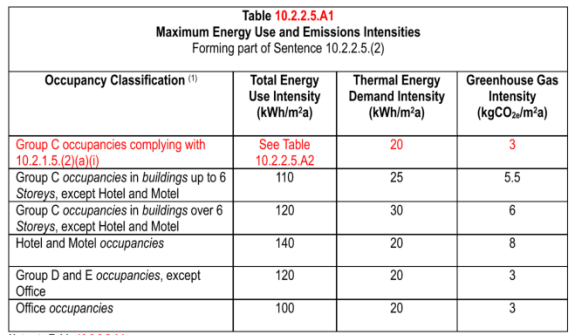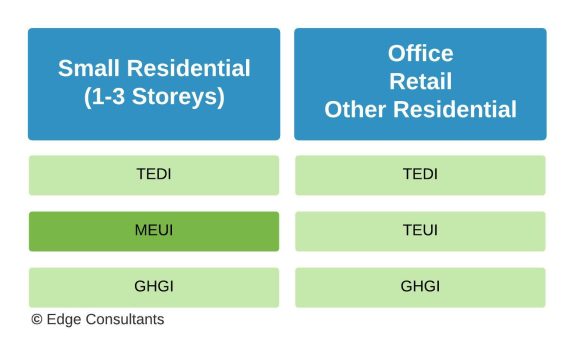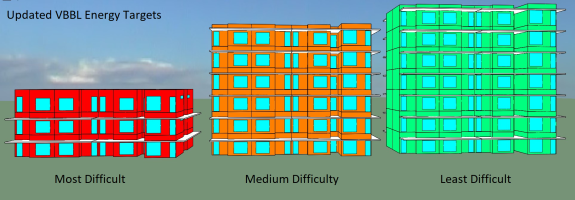As of January 01, 2022, Section 10.2 of the Vancouver Building By-Law (VBBL) has been updated. View the updated VBBL on the BC Publications Public Library or the City of Vancouver website.
Small residential buildings impacted (Section 10.2.1.5)
The updates are specific to smaller residential buildings. Sections 10.2.1.5 and 10.2.1.6 of the VBBL have now been combined in Section 10.2.1.5. This section applies to:
- All residential buildings that are one to three storeys in height
- Residential buildings that are greater than three storeys, if they contain no more than two principal dwelling units.
The table show below, which gives the maximum energy use and emission intensities by occupancy classification, now includes these smaller residential buildings that fall under Section 10.2.1.5.

How targets are set
In the past, table 10.2.2.5.A of the VBBL has set out energy efficiency requirements by setting maximum targets using three metrics: TEUI, TEDI, and GHGI. The links provided are to short Edge articles that explain these metrics.
However, this table has now been separated into tables 10.2.2.5.A1 and 10.2.2.5.A2. The first table (shown above) links to the second table which has another metric: MEUI. It stands for Mechanical Energy Use Intensity. So, maximum targets are now set using four metrics; TEUI, TEDI, GHGI, and MEUI.
Targets that apply to different building types
Targets differ by occupancy classification (building type). Residential buildings that fall under Section 10.2.1.5 have a MEUI target and it takes the place of TEUI. So, small residential buildings have MEUI, TEDI, and GHGI targets while all other occupancy classifications use TEUI, TEDI, and GHGI.

Table 10.2.2.5.A2. of the VBBL outlines the newly introduced MEUI targets for small residential buildings. The MEUI decreases as the building gets larger. So, the lower the floor area, the less stringent the MEUI target.

Comparing targets for different residential buildings
TEDI is typically the most difficult target to achieve. This is because there is more flexibility to make design changes to achieve the other metrics. Essentially, impacting TEDI boils down to improving the building envelope and maximizing heat recovered on ventilation air.
Residential buildings (not connected to a low-carbon energy system) now have three different TEDI targets. The number of storeys dictates the target. Buildings with less than four storeys have a TEDI target of 20, those with four to six storeys have a target of 25, and those greater than six must achieve 30 kWh/(m2.year).

As residential buildings decrease in size, the TEDI target becomes more difficult to achieve. TEDI is the most difficult target to achieve. As discussed in the TEDI article, the form/shape of a building has a large impact on the TEDI value. This is because, the higher the ratio of envelope area to floor area is, the more heat will be required.
So, in general, the targets are more difficult for smaller residential buildings. Comparing larger and smaller residential buildings, smaller ones will require a higher performing building envelope and higher heat recovery efficiency on ventilation air.
Disclaimer
This article is for supplementary information purposes only. It highlights updates to the VBBL in January 2022 only. Do not use the contents of this article in isolation. For context, read the requirements of the current and past versions of the VBBL. Access the current requirements of the VBBL on the City of Vancouver website or from the BC Publications Public Library.